
Welcome to fortlauderdalesnakes.com! I am David, a snake enthusiast living in Fort Lauderdale, FL. Many people don't know that Fort Lauderdale is in fact full of snakes! You just need to know where to find them - they can often be shy and elusive. Some Florida snake species are more common outside of the city limits, in different parts of Broward County FL, but many types of snakes are indeed common in the more urban parts of Fort Lauderdale. This guide is meant to help educate you about the beautiful snakes of Fort Lauderdale, and to help you identify the most common snakes of Fort Lauderdale, as well as the venomous snakes of Fort Lauderdale that you should learn to recognize and avoid. If you want more detail, click here for my complete list of ALL snake species in Fort Lauderdale. Remember the following:
- Most snakes of Fort Lauderdale are harmless and don't want to encounter you
- Venomous snakes exist but are uncommon in Fort Lauderdale, Florida
- Snakes eat rats and mice and are a valuable part of the Florida ecosystem
- Never kill a snake - if you leave a snake alone, it will leave you alone.
Common Snake Species in Fort Lauderdale
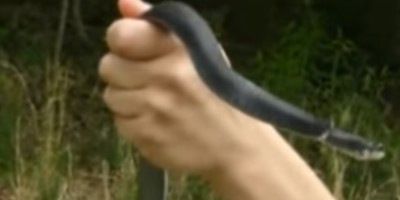 Black Racer Snake:
The black racer snake, also known as the North American racer, is a species of small to medium-sized snakes. These snakes can be anywhere between two and four feet in length, and they’re known for being quite slender. These snakes are black in color, but the undersides of their chins are white. Young black racer snakes, however, are grey in color. The young also have red patches covering their bodies. Black racer snakes are non-venomous, and they aren’t aggressive either. These snakes have a varied diet, and they’ll eat anything they can find. This includes eggs, small rodents and mammals, birds, insects, spiders, lizards, amphibians, and even other snakes. The black racer lives in a variety of locations, from forests to prairies. Yet it’s not unheard of for them to appear near suburban homes.
Black Racer Snake:
The black racer snake, also known as the North American racer, is a species of small to medium-sized snakes. These snakes can be anywhere between two and four feet in length, and they’re known for being quite slender. These snakes are black in color, but the undersides of their chins are white. Young black racer snakes, however, are grey in color. The young also have red patches covering their bodies. Black racer snakes are non-venomous, and they aren’t aggressive either. These snakes have a varied diet, and they’ll eat anything they can find. This includes eggs, small rodents and mammals, birds, insects, spiders, lizards, amphibians, and even other snakes. The black racer lives in a variety of locations, from forests to prairies. Yet it’s not unheard of for them to appear near suburban homes.
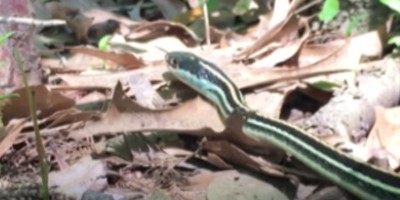 Common Garter Snake:
The common garter snake is a small, non-venomous snake. These reptiles are only two feet in size. Garter snakes come in a variety of colors, but they all maintain the same general pattern. These snakes have a dark body with three yellow or white lines running down their back, along with a yellow chin and belly. These snakes are found in a wide variety of environments. These include forests, plains, and wetlands. Common garter snakes can also be found in your garden, where they’re known to prey on small pests. Their diet consists of worms, slugs, and insects. They’ll also eat small rodents, fish, and amphibians.
Common Garter Snake:
The common garter snake is a small, non-venomous snake. These reptiles are only two feet in size. Garter snakes come in a variety of colors, but they all maintain the same general pattern. These snakes have a dark body with three yellow or white lines running down their back, along with a yellow chin and belly. These snakes are found in a wide variety of environments. These include forests, plains, and wetlands. Common garter snakes can also be found in your garden, where they’re known to prey on small pests. Their diet consists of worms, slugs, and insects. They’ll also eat small rodents, fish, and amphibians.
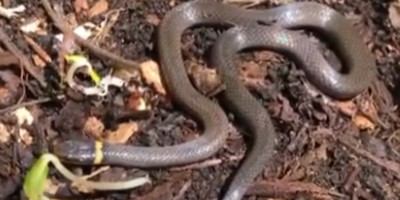 Ring-Necked Snake:
The ring-necked snake is another small, non-venomous snake, and it’s quite common in parts of the United States. These snakes are even smaller than garter snakes, as most are only one foot in size. You can identify a ring-necked snake by its dark body, which is highlighted with an orange or yellow ring around its neck. These snakes also have a colorful belly, and are typically orange, yellow, or white in color. These snakes typically live under rocks and fallen logs. They’re also known to hibernate underground during parts of the year. Ring-necked snakes primarily feed on amphibians. They’re especially fond of red-backed salamanders. Yet they’ll also eat slugs, insects, and other small creatures.
Ring-Necked Snake:
The ring-necked snake is another small, non-venomous snake, and it’s quite common in parts of the United States. These snakes are even smaller than garter snakes, as most are only one foot in size. You can identify a ring-necked snake by its dark body, which is highlighted with an orange or yellow ring around its neck. These snakes also have a colorful belly, and are typically orange, yellow, or white in color. These snakes typically live under rocks and fallen logs. They’re also known to hibernate underground during parts of the year. Ring-necked snakes primarily feed on amphibians. They’re especially fond of red-backed salamanders. Yet they’ll also eat slugs, insects, and other small creatures.
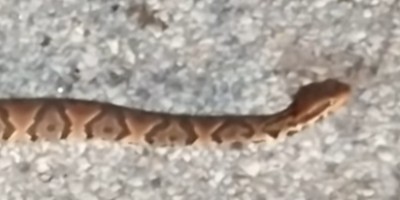 Cottonmouth:
Cottonmouths or water moccasins are another species of highly venomous snakes, and they’re quite common in Florida and other South-Eastern states. These snakes are typically two to four feet long, but some adults are able to reach six feet in length. These snakes have a light brown body with lots of different dark brown patches covering it. What these snakes are well-known for is the white insides of their mouths, for which they get the name “cottonmouth”. Like other water snakes, the cottonmouth tends to live near bodies of water. These include rivers, lakes, swamps, and plenty of others. While these snakes do primarily eat fish, amphibians, and other aquatic animals. They will hunt and eat any nearby animal, such as birds, small mammals, and even other cottonmouth snakes.
Cottonmouth:
Cottonmouths or water moccasins are another species of highly venomous snakes, and they’re quite common in Florida and other South-Eastern states. These snakes are typically two to four feet long, but some adults are able to reach six feet in length. These snakes have a light brown body with lots of different dark brown patches covering it. What these snakes are well-known for is the white insides of their mouths, for which they get the name “cottonmouth”. Like other water snakes, the cottonmouth tends to live near bodies of water. These include rivers, lakes, swamps, and plenty of others. While these snakes do primarily eat fish, amphibians, and other aquatic animals. They will hunt and eat any nearby animal, such as birds, small mammals, and even other cottonmouth snakes.
Venomous Snake Species in Fort Lauderdale
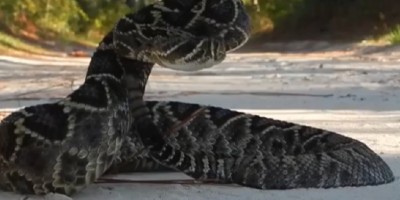 Eastern Diamondback Rattlesnake:
The eastern diamondback rattlesnake is one of four venomous snakes found in Fort Lauderdale. It’s also the largest venomous snake found in North America. Most of these snakes are close to six feet in size, but some can be eight feet long. The snake gets its name from the dark diamond-shaped patches running across its entire body. These tend to be brown in color with a cream-colored outline. Despite being very venomous, the eastern diamondback rattlesnake isn’t aggressive. In fact, most of these snakes’ bites happen when someone intentionally bothers them, or if they’re stepped on. These rattlesnakes primarily feed on small mammals. These include rabbits, rats, and even squirrels. Yet these rattlesnakes are known to go after birds on occasion.
Eastern Diamondback Rattlesnake:
The eastern diamondback rattlesnake is one of four venomous snakes found in Fort Lauderdale. It’s also the largest venomous snake found in North America. Most of these snakes are close to six feet in size, but some can be eight feet long. The snake gets its name from the dark diamond-shaped patches running across its entire body. These tend to be brown in color with a cream-colored outline. Despite being very venomous, the eastern diamondback rattlesnake isn’t aggressive. In fact, most of these snakes’ bites happen when someone intentionally bothers them, or if they’re stepped on. These rattlesnakes primarily feed on small mammals. These include rabbits, rats, and even squirrels. Yet these rattlesnakes are known to go after birds on occasion.
If you're unsure, you can email me a photo of the snake at info@fortlauderdalesnakes.com and I will email you back with the snake's species. If you found a snake skin, read my Found a Skin? page, and you can email me a photo of the skin, and I'll identify the snake for you. If you need professional Fort Lauderdale snake removal help, click my Get Help page, or see the below website sponsor I found, who provides that service.
Remember, the term is not poisonous snakes of Fort Lauderdale, it's venomous snakes of Fort Lauderdale. Poison is generally something you eat, and venom is injected into you. That said, dangerous snakes are very rare in Fort Lauderdale. The few venomous snakes of Broward County are rarely seen. But they are commonly misidentified, so learn about all the snake species of Fort Lauderdale in order to correctly identify them. These snakes are usually also found in the surrounding towns of Pompano Beach, Hollywood, Coral Springs, Pembroke Pines, Plantation, Davie, Deerfield Beach, Miramar, Sunrise, Weston, Coconut Creek, Margate, Tamarac, Lauderhill, Hallandale Beach, Lauderdale Lakes, Oakland Park, Dania Beach, Lauderdale-by-the-Sea, North Lauderdale, Cooper City, Wilton Manors, Lighthouse Point, Southwest Ranches, West Park, Pembroke Park, Hillsboro Beach, Sea Ranch Lakes, Lazy Lake, Sunshine Acres, Pine Island Ridge, Broadview Park, Hillsboro Pines, Roos, and the surrounding areas.
Read our article about:
What Are the Predators of Snakes?
fortlauderdalesnakes.com domain and hosting costs made possible by the generous support of this sponsor:
